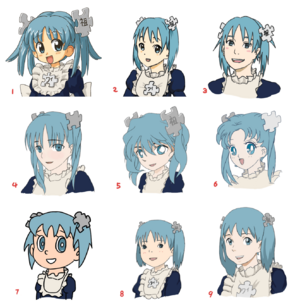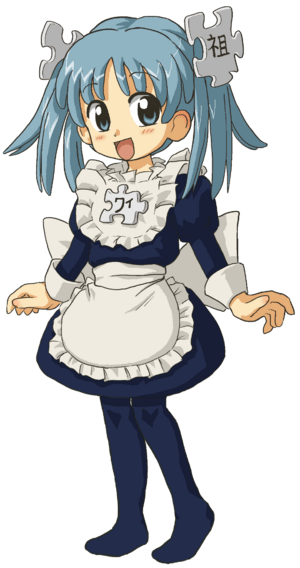Anime facts for kids
Anime (アニメ) is hand-drawn and computer-generated animation originating from Japan. Outside Japan and in English, anime refers specifically to animation produced in Japan. However, in Japan and in Japanese, anime (a term derived from a shortening of the English word animation) describes all animated works, regardless of style or origin.
The earliest commercial Japanese animation dates to 1917. A characteristic art style emerged in the 1960s with the works of cartoonist Osamu Tezuka and spread in following decades, developing a large domestic audience. In addition to original works, anime are often adaptations of Japanese comics (manga), light novels, or video games. It is classified into numerous genres targeting various broad and niche audiences.
Modern anime follows a typical animation production process, involving storyboarding, voice acting, character design, and cel production. Since the 1990s, animators have increasingly used computer animation to improve the efficiency of the production process.
Very popular stories in anime and manga are often translated into other languages, and the words used in the anime or manga will be put into another language where they mean the same thing.
Contents
History
The history of anime begins around 1900, when Japanese filmmakers tried out ways of animation at the same time as the United States, Russia, Germany and France.
The filmmakers in Japan did not have a lot of money to make their movies and not a lot of places where they could film their movies. The people that the filmmakers could use as actors in their movies was also a problem for making Japanese movies. Japanese people look different from people in other places in the world, and it was hard for filmmakers to make a movie about places other than Japan with Japanese actors. Movie makers liked animation because then they could have animator draw other places and people that could not be filmed in a normal movie, and the animators could be very creative with the cartoons they made.
During the 1970s, more and more people started to like manga. At the same time, manga were used as the starting point to make anime with the same characters and stories. Animators would take the drawings done by a manga artist and the stories the manga artist wrote, and turn them into the stories and characters of a similar anime. At that time Osamu Tezuka became very popular. Now he is called a "legend" and the "god of manga". Tezuka and other pioneers of anime made a lot of types of stories and styles that are common to anime today. The giant robot genre (known as "mecha" outside Japan) began with manga and anime from Tezuka's ideas. Robot anime like Gundam and Macross became classics in the 1980s. Today, the robot genre is still very popular in Japan and worldwide. In the 1980s, anime became very popular in Japan, and saw an increase in production. (Manga is much more popular than anime in Japan).
Attributes
Anime differs from other forms of animation by its art styles, methods of animation, its production, and its process. Visually, anime works exhibit a wide variety of art styles, differing between creators, artists, and studios. While no single art style predominates anime as a whole, they do share some similar attributes in terms of animation technique and character design.
Anime is fundamentally characterized by the use of limited animation, flat expression, the suspension of time, its thematic range, the presence of historical figures, its complex narrative line and, above all, a peculiar drawing style, with characters characterized by large and oval eyes, with very defined lines, bright colors and reduced movement of the lips.
Technique
Modern anime follows a typical animation production process, involving storyboarding, voice acting, character design, and cel production. Since the 1990s, animators have increasingly used computer animation to improve the efficiency of the production process. Early anime works were experimental, and consisted of images drawn on blackboards, stop motion animation of paper cutouts, and silhouette animation. Cel animation grew in popularity until it came to dominate the medium. In the 21st century, the use of other animation techniques is mostly limited to independent short films, including the stop motion puppet animation work produced by Tadahito Mochinaga, Kihachirō Kawamoto and Tomoyasu Murata. Computers were integrated into the animation process in the 1990s, with works such as Ghost in the Shell and Princess Mononoke mixing cel animation with computer-generated images. Fuji Film, a major cel production company, announced it would stop cel production, producing an industry panic to procure cel imports and hastening the switch to digital processes.
Prior to the digital era, anime was produced with traditional animation methods using a pose to pose approach. The majority of mainstream anime uses fewer expressive key frames and more in-between animation.
Japanese animation studios were pioneers of many limited animation techniques, and have given anime a distinct set of conventions. Unlike Disney animation, where the emphasis is on the movement, anime emphasizes the art quality and let limited animation techniques make up for the lack of time spent on movement. Such techniques are often used not only to meet deadlines but also as artistic devices. Anime scenes place emphasis on achieving three-dimensional views, and backgrounds are instrumental in creating the atmosphere of the work. The backgrounds are not always invented and are occasionally based on real locations, as exemplified in Howl's Moving Castle and The Melancholy of Haruhi Suzumiya. Oppliger stated that anime is one of the rare mediums where putting together an all-star cast usually comes out looking "tremendously impressive".
The cinematic effects of anime differentiates itself from the stage plays found in American animation. Anime is cinematically shot as if by camera, including panning, zooming, distance and angle shots to more complex dynamic shots that would be difficult to produce in reality. In anime, the animation is produced before the voice acting, contrary to American animation which does the voice acting first.
Characters
The body proportions of human anime characters tend to accurately reflect the proportions of the human body in reality. The height of the head is considered by the artist as the base unit of proportion. Head heights can vary, but most anime characters are about seven to eight heads tall. Anime artists occasionally make deliberate modifications to body proportions to produce super deformed characters that feature a disproportionately small body compared to the head; many super deformed characters are two to four heads tall.

A common anime character design convention is exaggerated eye size.
Hair in anime is often unnaturally lively and colorful or uniquely styled.
Anime and manga artists often draw from a common canon of iconic facial expression illustrations to denote particular moods and thoughts. A variety of visual symbols are employed, including sweat drops to depict nervousness, visible blushing for embarrassment, or glowing eyes for an intense glare.
Types of anime
Related pages
Images for kids
See also
 In Spanish: Anime para niños
In Spanish: Anime para niños






